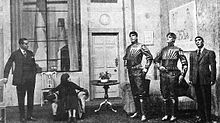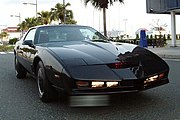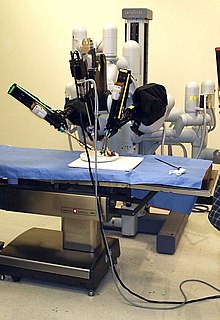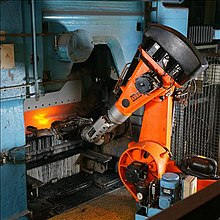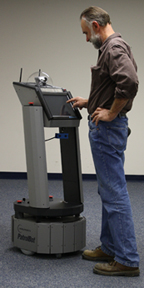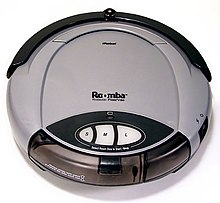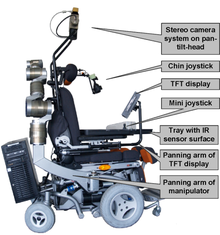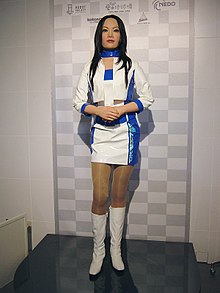A robot is a virtual or mechanical artificial agent. In practice, it is usually an electro-mechanical machine which is guided by computer or electronic programming, and is thus able to do tasks on its own. Another common characteristic is that by its appearance or movements, a robot often conveys a sense that it has intent or agency of its own.
Origins
| This article is written like a personal reflection or essay and may require cleanup. Please help improve it by rewriting it in an encyclopedic style. (November 2010) |
When civilised societies started, nearly all production and effort was the result of human labour. As mechanical means of performing functions were discovered, and mechanics and complex mechanisms were developed, the need for human labour was reduced. Initially, machinery was used for repetitive functions such as lifting water and grinding grain. With technological advances more complex machines were slowly developed, such as those invented by Hero of Alexandria. They were not widely adopted as human labour, particularly slave labour, was still inexpensive compared to the capital-intensive machines.
In the second half of the second millennium man began to develop more complex machines as well as rediscovering the Greek engineering methods. Men such as Leonardo Da Vinci in 1495 through to Jacques de Vaucanson in 1739 have made plans for, and built, automata and robots leading to books of designs such as the Japanese Karakuri zui (Illustrated Machinery) in 1796. As mechanical techniques developed through the Industrial age we find more practical applications such as Nikola Tesla in 1898 who designed a radio-controlled torpedo and the Westinghouse Electric Corporation creation Televox in 1926. From here we find a more android development as designers tried to mimic more human-like features including designs such as those of biologist Makoto Nishimura in 1929 and his creation Gakutensoku, which cried and changed its facial expressions, and the more crude Elektro from Westinghouse in 1938.
Electronics now became the driving force of development instead of mechanics with the advent of the first electronic autonomous robots created by William Grey Walter inBristol, England in 1948. The first digital and programmable robot was invented by George Devol in 1954 and was ultimately called the Unimate. Devol sold the first Unimate to General Motors in 1960 where it was used to lift pieces of hot metal from die casting machines in a plant in Trenton, New Jersey.
Since then we have seen robots finally reach a more true assimilation of all technologies to produce robots such as ASIMO which can walk and move like a human. Robots have replaced slaves in the assistance of performing those repetitive and dangerous tasks which humans prefer not to do or unable to do due to size limitations or even those such as in outer space or at the bottom of the sea where humans could not survive the extreme environments.
Robots come in those two basic forms: Those which are used to make or move things, such as Industrial robots or mobile or servicing robots and those which are used for research into human-like robots such as ASIMO and TOPIO as well as those into more defined and specific roles such as Nano robots and Swarm robots.
Man has developed a fear of the autonomous robot and how it may react in society, such as Shelley's Frankenstein and the EATR, and yet we still use robots in a wide variety of tasks such as vacuuming floors, mowing lawns, cleaning drains, investigating other planets, building cars, entertainment and in warfare.
Etymology
See also: Glossary of robotics
The word robot was introduced to the public by the Czech interwar writer Karel Čapek in his play R.U.R. (Rossum's Universal Robots), published in 1920.[3]The play begins in a factory that makes artificial people called robots, though they are closer to the modern ideas of androids, creatures who can be mistaken for humans. They can plainly think for themselves, though they seem happy to serve. At issue is whether the robots are being exploited and the consequences of their treatment.
Karel Čapek himself did not coin the word. He wrote a short letter in reference to an etymology in the Oxford English Dictionary in which he named his brother, the painter and writer Josef Čapek, as its actual originator.[3]
In an article in the Czech journal Lidové noviny in 1933, he explained that he had originally wanted to call the creatures laboři ("workers", from Latin labor). However, he did not like the word, and sought advice from his brother Josef, who suggested "roboti". The word robota means literally "work", "labor" or "corvée", "serf labor", and figuratively "drudgery" or "hard work" in Czech and many Slavic languages. Traditionally the robota was the work period a serf (corvée) had to give for his lord, typically 6 months of the year. The origin of the word is the Old Church Slavonic rabota "servitude" ("work" in contemporaryBulgarian and Russian), which in turn comes from the Indo-European root *orbh-.[4] Serfdom was outlawed in 1848 in Bohemia, so at the time Čapek wroteR.U.R., usage of the term robota had broadened to include various types of work, but the obsolete sense of "serfdom" would still have been known.[5]
The word robotics, used to describe this field of study, was coined by the science fiction writer Isaac Asimov. Asimov and John W. Campbell created the "Three Laws of Robotics" which are a recurring theme in his books. These have since been used by many others to define laws used in fact and fiction. Introduced in his 1942 short story "Runaround" the Laws state the following:
| “ |
| ” |
History
Main article: History of robots
Many ancient mythologies include artificial people, such as the mechanical servants built by the Greek god Hephaestus[6] (Vulcan to the Romans), the clay golems of Jewish legend and clay giants of Norse legend, and Galatea, the mythical statue of Pygmalion that came to life. In Greek drama, Deus Ex Machina was contrived as a dramatic device that usually involved lowering a deity by wires into the play to solve a seemingly impossible problem.
According to Mark E. Rosheim, "The beginning of robots may be traced to the great Greek engineer Ctesibius (c. 270 BC). ... Ctesibius applied a knowledge of pneumatics and hydraulics to produce the first organ and water clocks with moving figures."[7][8] In the 4th century BC, the Greek mathematician Archytas of Tarentum postulated a mechanical steam-operated bird he called "The Pigeon".Hero of Alexandria (10–70 AD), a Greek mathematician and inventor, created numerous user-configurable automated devices, and described machines powered by air pressure, steam and water.[9] Su Song built a clock tower in China in 1088 featuring mechanical figurines that chimed the hours.[10]
In the 3rd century BC text of the Lie Zi, there is a curious account on automata involving a much earlier encounter between King Mu of Zhou (Chinese emperor 10th century BC) and a mechanical engineer known as Yan Shi , an 'artificer'. The latter proudly presented the king with a life-size, human-shaped figure of his mechanical 'handiwork' made of leather, wood, and artificial organs.[11]
Al-Jazari (1136–1206), a Muslim inventor during the Artuqid dynasty, designed and constructed a number of automated machines, including kitchen appliances, musical automata powered by water, and programmable automata.[12][13] The robots appeared as four musicians on a boat in a lake, entertaining guests at royal drinking parties. His mechanism had a programmable drum machine with pegs (cams) that bumped into little levers that operated percussion instruments. The drummer could be made to play different rhythms and different drum patterns by moving the pegs to different locations.[12][13]
Early modern developments
Leonardo da Vinci (1452–1519) sketched plans for a humanoid robot around 1495. Da Vinci's notebooks, rediscovered in the 1950s, contain detailed drawings of a mechanical knight now known asLeonardo's robot, able to sit up, wave its arms and move its head and jaw.[14] The design was probably based on anatomical research recorded in his Vitruvian Man. It is not known whether he attempted to build it. In 1738 and 1739, Jacques de Vaucanson exhibited several life-sized automatons: a flute player, a pipe player and a duck. The mechanical duck could flap its wings, crane its neck, and swallow food from the exhibitor's hand, and it gave the illusion of digesting its food by excreting matter stored in a hidden compartment.[15] Complex mechanical toys and animals built in Japan in the 18th century were described in the Karakuri zui (Illustrated Machinery, 1796)
Modern developments
The Japanese craftsman Hisashige Tanaka (1799–1881), known as "Japan's Edison" or "Karakuri Giemon", created an array of extremely complex mechanical toys, some of which served tea, fired arrows drawn from a quiver, and even painted a Japanese kanji character.[16] In 1898 Nikola Tesla publicly demonstrated a radio-controlled torpedo.[17] Based on patents for "teleautomation", Tesla hoped to develop it into a weapon system for the US Navy.[18][19]
In 1926, Westinghouse Electric Corporation created Televox, the first robot put to useful work. They followed Televox with a number of other simple robots, including one called Rastus, made in the crude image of a black man. In the 1930s, they created a humanoid robot known as Elektro for exhibition purposes, including the 1939 and 1940 World's Fairs.[20][21] In 1928, Japan's first robot,Gakutensoku, was designed and constructed by biologist Makoto Nishimura.
The first electronic autonomous robots were created by William Grey Walter of the Burden Neurological Institute at Bristol, England in 1948 and 1949. They were named Elmer and Elsie. These robots could sense light and contact with external objects, and use these stimuli to navigate.[22]
The first truly modern robot, digitally operated and programmable, was invented by George Devol in 1954 and was ultimately called the Unimate. Devol sold the first Unimate to General Motors in 1960, and it was installed in 1961 in a plant in Trenton, New Jersey to lift hot pieces of metal from a die casting machine and stack them.[23]
Commercial and industrial robots are now in widespread use performing jobs more cheaply or with greater accuracy and reliability than humans. They are also employed for jobs which are too dirty, dangerous or dull to be suitable for humans. Robots are widely used in manufacturing, assembly and packing, transport, earth and space exploration, surgery, weaponry, laboratory research, and mass production of consumer and industrial goods.[24]
Definitions
The word robot can refer to both physical robots and virtual software agents, but the latter are usually referred to as bots.[25] There is no consensus on which machines qualify as robots but there is general agreement among experts, and the public, that robots tend to do some or all of the following: move around, operate a mechanical limb, sense and manipulate their environment, and exhibit intelligent behavior — especially behavior which mimics humans or other animals.
There is no one definition of robot which satisfies everyone and many people have their own.[26] For example Joseph Engelberger, a pioneer in industrial robotics, once remarked: "I can't define a robot, but I know one when I see one."[27] According to the Encyclopaedia Britannica a robot is "any automatically operated machine that replaces human effort, though it may not resemble human beings in appearance or perform functions in a humanlike manner".[28] Merriam-Webster describes a robot as a "machine that looks like a human being and performs various complex acts (as walking or talking) of a human being", or a "device that automatically performs complicated often repetitive tasks", or a "mechanism guided by automatic controls".[29]
Defining characteristics
While there is no single correct definition of "robot,"[30] a typical robot will have several, or possibly all, of the following characteristics.
It is an electric machine which has some ability to interact with physical objects and to be given electronic programming to do a specific task or to do a whole range of tasks or actions. It may also have some ability to perceive and absorb data on physical objects, or on its local physical environment, or to process data, or to respond to various stimuli. This is in contrast to a simple mechanical device such as a gear or a hydraulic press or any other item which has no processing ability and which does tasks through purely mechanical processes and motion.
- Mental agency
For robotic engineers, the physical appearance of a machine is less important than the way its actions are controlled. The more the control system seems to have agency of its own, the more likely the machine is to be called a robot. An important feature of agency is the ability to make choices. Higher-level cognitive functions, though, are not necessary, as shown by ant robots.
- A clockwork car is never considered a robot.
- A mechanical device able to perform some preset motions but with no ability to adapt (an automaton) is rarely considered a robot.
- A remotely-operated vehicle is sometimes considered a robot (or telerobot).[31]
- A car with an onboard computer, like Bigtrak, which could drive in a programmable sequence, might be called a robot.
- A self-controlled car which could sense its environment and make driving decisions based on this information, such as the 1990s driverless cars of Ernst Dickmanns or the entries in the DARPA Grand Challenge, would quite likely be called a robot.
- A sentient car, like the fictional KITT, which can make decisions, navigate freely and converse fluently with a human, is usually considered a robot.
- Physical agency
However, for many laymen, if a machine appears to be able to control its arms or limbs, and especially if it appears anthropomorphic or zoomorphic (e.g. ASIMO or Aibo), it would be called a robot.
- A player piano is rarely characterized as a robot.[32]
- A CNC milling machine is very occasionally characterized as a robot.
- A factory automation arm is almost always characterized as an industrial robot.
- An autonomous wheeled or tracked device, such as a self-guided rover or self-guided vehicle, is almost always characterized as a mobile robot or service robot.
- A zoomorphic mechanical toy, like Roboraptor, is usually characterized as a robot.[33]
- A mechanical humanoid, like ASIMO, is almost always characterized as a robot, usually as a service robot.
Even for a 3-axis CNC milling machine using the same control system as a robot arm, it is the arm which is almost always called a robot, while the CNC machine is usually just a machine. Having eyes can also make a difference in whether a machine is called a robot, since humans instinctively connect eyes with sentience. However, simply being anthropomorphic is not a sufficient criterion for something to be called a robot. A robot must do something; an inanimate object shaped like ASIMO would not be considered a robot.
Modern robots
Mobile robot
Main articles: Mobile robot and Automated guided vehicle
Mobile robots have the capability to move around in their environment and are not fixed to one physical location. An example of a mobile robot that is in common use today is the automated guided vehicle or automatic guided vehicle (AGV). An AGV is a mobile robot that follows markers or wires in the floor, or uses vision or lasers. AGVs are discussed later in this article.
Mobile robots are also found in industry, military and security environments. They also appear as consumer products, for entertainment or to perform certain tasks like vacuum cleaning. Mobile robots are the focus of a great deal of current research and almost every major university has one or more labs that focus on mobile robot research.
Modern robots are usually used in tightly controlled environments such as on assembly lines because they have difficulty responding to unexpected interference. Because of this most humans rarely encounter robots. However domestic robots for cleaning and maintenance are increasingly common in and around homes in developed countries. Robots can also be found in military applications.
Industrial robots (manipulating)
Main articles: Industrial robot and Service robot
Industrial robots usually consist of a jointed arm (multi-linked manipulator) and end effector that is attached to a fixed surface. One of the most common type of end effector is a gripper assembly.
The International Organization for Standardization gives a definition of a manipulating industrial robot in ISO 8373:
"an automatically controlled, reprogrammable, multipurpose, manipulator programmable in three or more axes, which may be either fixed in place or mobile for use in industrial automation applications."[34]
This definition is used by the International Federation of Robotics, the European Robotics Research Network (EURON) and many national standards committees.[35]
Service robot
Most commonly industrial robots are fixed robotic arms and manipulators used primarily for production and distribution of goods. The term "service robot" is less well-defined. IFR has proposed a tentative definition, "A service robot is a robot which operates semi- or fully- autonomously to perform services useful to the well-being of humans and equipment, excluding manufacturing operations."
In South Africa robot is an informal and commonly used term for a set of traffic lights.
Social impact
Roughly half of all the robots in the world are in Asia, 32% in Europe, and 16% in North America, 1% in Australasia and 1% in Africa.[36] 30% of all the robots in the world are in Japan,[37] making Japan the country with the highest number of robots.
Regional perspectives
In Japan and South Korea, ideas of future robots have been mainly positive, and the start of the pro-robotic society there is thought to be possibly due to the famous 'Astro Boy'. Asian societies such as Japan, South Korea, and more recently, China, believe robots to be more equal to humans, having them care for old people, play with or teach children, or replace pets etc.[38] The general view in Asian cultures is that the more robots advance, the better.
"This is the opening of an era in which human beings and robots can co-exist," says Japanese firm Mitsubishi about one of the many humanistic robots in Japan.[39] South Korea aims to put a robot in every house there by 2015-2020 in order to help catch up technologically with Japan.[40][41]
Western societies are more likely to be against, or even fear the development of robotics, through much media output in movies and literature that they will replace humans. Some believe that the West regards robots as a 'threat' to the future of humans, partly due to religious beliefs about the role of humans and society.[42][43] Obviously, these boundaries are not clear, but there is a significant difference between the two cultural viewpoints.
Autonomy and ethical questions
As robots have become more advanced and sophisticated, experts and academics have increasingly explored the questions of what ethics might govern robots' behavior,[44] and whether robots might be able to claim any kind of social, cultural, ethical or legal rights.[45] One scientific team has said that it is possible that a robot brain will exist by 2019.[46] Others predict robot intelligence breakthroughs by 2050.[47] Recent advances have made robotic behavior more sophisticated.[48]
Vernor Vinge has suggested that a moment may come when computers and robots are smarter than humans. He calls this "the Singularity".[49] He suggests that it may be somewhat or possibly very dangerous for humans.[50] This is discussed by a philosophy called Singularitarianism.
In 2009, experts attended a conference hosted by the Association for the Advancement of Artificial Intelligence (AAAI) to discuss whether computers and robots might be able to acquire any autonomy, and how much these abilities might pose a threat or hazard. They noted that some robots have acquired various forms of semi-autonomy, including being able to find power sources on their own and being able to independently choose targets to attack with weapons. They also noted that some computer viruses can evade elimination and have achieved "cockroach intelligence." They noted that self-awareness as depicted in science-fiction is probably unlikely, but that there were other potential hazards and pitfalls.[49] Various media sources and scientific groups have noted separate trends in differing areas which might together result in greater robotic functionalities and autonomy, and which pose some inherent concerns.[51][52][53]
Military robots
Main article: Military robots
Some experts and academics have questioned the use of robots for military combat, especially when such robots are given some degree of autonomous functions.[54] There are also concerns about technology which might allow some armed robots to be controlled mainly by other robots.[55] The US Navy has funded a report which indicates that as military robots become more complex, there should be greater attention to implications of their ability to make autonomous decisions.[56][57] One researcher states that autonomous robots might be more humane, as they could make decisions more effectively. However, other experts question this.[58]
Some public concerns about autonomous robots have received media attention.[59] One robot in particular, the EATR, has generated concerns over its fuel source as it can continually refuel itself using organic substances.[60] Although the engine for the EATR is designed to run on biomass and vegetation[61] specifically selected by its sensors which can find on battlefields or other local environments the project has stated that chicken fat can also be used.[62]
Contemporary uses
See also: List of Robots
At present there are 2 main types of robots, based on their use: general-purpose autonomous robots and dedicated robots.
Robots can be classified by their specificity of purpose. A robot might be designed to perform one particular task extremely well, or a range of tasks less well. Of course, all robots by their nature can be re-programmed to behave differently, but some are limited by their physical form. For example, a factory robot arm can perform jobs such as cutting, welding, gluing, or acting as a fairground ride, while a pick-and-place robot can only populate printed circuit boards.
General-purpose autonomous robots
General-purpose autonomous robots can perform a variety of functions independently. General-purpose autonomous robots typically can navigate independently in known spaces, handle their own re-charging needs, interface with electronic doors and elevators and perform other basic tasks. Like computers, general-purpose robots can link with networks, software and accessories that increase their usefulness. They may recognize people or objects, talk, provide companionship, monitor environmental quality, respond to alarms, pick up supplies and perform other useful tasks. General-purpose robots may perform a variety of functions simultaneously or they may take on different roles at different times of day. Some such robots try to mimic human beings and may even resemble people in appearance; this type of robot is called a humanoid robot.
Factory robots
Over the last three decades automobile factories have become dominated by robots. A typical factory contains hundreds of industrial robots working on fully automated production lines, with one robot for every ten human workers. On an automated production line, a vehicle chassis on a conveyor is welded, glued, painted and finally assembled at a sequence of robot stations.
Industrial robots are also used extensively for palletizing and packaging of manufactured goods, for example for rapidly taking drink cartons from the end of a conveyor belt and placing them into boxes, or for loading and unloading machining centers.
Mass-produced printed circuit boards (PCBs) are almost exclusively manufactured by pick-and-place robots, typically with SCARA manipulators, which remove tinyelectronic components from strips or trays, and place them on to PCBs with great accuracy.[63] Such robots can place hundreds of thousands of components per hour, far out-performing a human in speed, accuracy, and reliability.[64]
- Automated guided vehicles (AGVs)
Mobile robots, following markers or wires in the floor, or using vision[65] or lasers, are used to transport goods around large facilities, such as warehouses, container ports, or hospitals.[66]
-
- Early AGV-Style Robots
- Limited to tasks that could be accurately defined and had to be performed the same way every time. Very little feedback or intelligence was required, and the robots needed only the most basic exteroceptors (sensors). The limitations of these AGVs are that their paths are not easily altered and they cannot alter their paths if obstacles block them. If one AGV breaks down, it may stop the entire operation.
-
- Interim AGV-Technologies
- Developed to deploy triangulation from beacons or bar code grids for scanning on the floor or ceiling. In most factories, triangulation systems tend to require moderate to high maintenance, such as daily cleaning of all beacons or bar codes. Also, if a tall pallet or large vehicle blocks beacons or a bar code is marred, AGVs may become lost. Often such AGVs are designed to be used in human-free environments.
-
- Intelligent AGVs (i-AGVs)
- Such as SpeciMinder,[67] ADAM,[68] Tug[69] and MT 400 with Motivity[70] are designed for people-friendly workspaces. They navigate by recognizing natural features. 3D scanners or other means of sensing the environment in two or three dimensions help to eliminate cumulative errors in dead-reckoning calculations of the AGV's current position. Some AGVs can create maps of their environment using scanning lasers with simultaneous localization and mapping (SLAM) and use those maps to navigate in real time with other path planning and obstacle avoidance algorithms. They are able to operate in complex environments and perform non-repetitive and non-sequential tasks such as transporting photomasks in a semiconductor lab, specimens in hospitals and goods in warehouses. For dynamic areas, such as warehouses full of pallets, AGVs require additional strategies using three-dimensional sensors such as time-of-flight or stereovision cameras.
Dirty, dangerous, dull or inaccessible tasks
There are many jobs which humans would rather leave to robots. The job may be boring, such as domestic cleaning, or dangerous, such as exploring inside avolcano.[71] Other jobs are physically inaccessible, such as exploring another planet,[72] cleaning the inside of a long pipe, or performing laparoscopicsurgery.[73]
- Space probes
Almost every unmanned space probe ever launched was a robot. Some were launched in the 1960s with more limited abilities, but their ability to fly and to land (in the case of Luna 9) is an indication of their status as a robot. This includes the Voyager probes and the Galileo probes, as well as other probes.
When a human cannot be present on site to perform a job because it is dangerous, far away, or inaccessible, teleoperated robots, or telerobots are used. Rather than following a predetermined sequence of movements, a telerobot is controlled from a distance by a human operator. The robot may be in another room or another country, or may be on a very different scale to the operator. For instance, a laparoscopic surgery robot allows the surgeon to work inside a human patient on a relatively small scale compared to open surgery, significantly shortening recovery time.[73] When disabling a bomb, the operator sends a small robot to disable it. Several authors have been using a device called the Longpen to sign books remotely.[74] Teleoperated robot aircraft, like the PredatorUnmanned Aerial Vehicle, are increasingly being used by the military. These pilotless drones can search terrain and fire on targets.[75][76] Hundreds of robots such as iRobot's Packbot and the Foster-Miller TALON are being used in Iraq and Afghanistan by the U.S. military to defuse roadside bombs or Improvised Explosive Devices (IEDs) in an activity known as explosive ordnance disposal (EOD).[77]
Used to pick fruit on orchards at a cost lower than that of human pickers.
As prices fall and robots become smarter and more autonomous, simple robots dedicated to a single task work in over a million homes. They are taking on simple but unwanted jobs, such as vacuum cleaning and floor washing, and lawn mowing. Some find these robots to be cute and entertaining, which is one reason that they can sell very well.
In the hazardous and tight spaces of a building's duct work, many hours can be spent cleaning relatively small areas if a manual brush is used. Robots have been used by many duct cleaners primarily in the industrial and institutional cleaning markets, as they allow the job to be done faster, without exposing workers to the harmful enzymes released by dust mites. For cleaning high-security institutions such as embassies and prisons, duct cleaning robots are vital, as they allow the job to be completed without compromising the security of the institution. Hospitals and other government buildings with hazardous and cancerogenic environments such as nuclear reactors legally must be cleaned using duct cleaning robots, in countries such as Canada, in an effort to improve workplace safety in duct cleaning.
Military robots
Military robots include the SWORDS robot which is currently used in ground-based combat. It can use a variety of weapons and there is some discussion of giving it some degree of autonomy in battleground situations.[78][79][80]
Unmanned combat air vehicles (UCAVs), which are an upgraded form of UAVs, can do a wide variety of missions, including combat. UCAVs are being designed such as the Mantis UCAV which would have the ability to fly themselves, to pick their own course and target, and to make most decisions on their own.[81] The BAE Taranis is a UCAV built by Great Britain which can fly across continents without a pilot and has new means to avoid detection.[82] Flight trials are expected to begin in 2011.[83][84]
The AAAI has studied this topic in depth[44] and its president has commissioned a study to look at this issue.[85]
Some have suggested a need to build "Friendly AI", meaning that the advances which are already occurring with AI should also include an effort to make AI intrinsically friendly and humane.[86] Several such measures reportedly already exist, with robot-heavy countries such as Japan and South Korea[40] having begun to pass regulations requiring robots to be equipped with safety systems, and possibly sets of 'laws' akin to Asimov's Three Laws of Robotics.[87][88] An official report was issued in 2009 by the Japanese government's Robot Industry Policy Committee.[89] Chinese officials and researchers have issued a report suggesting a set of ethical rules, as well as a set of new legal guidelines referred to as "Robot Legal Studies."[90] Some concern has been expressed over a possible occurrence of robots telling apparent falsehoods.[91]
Schools
Robotics have also been introduced into the lives of elementary and high school students with the company FIRST (For Inspiration and Recognition of Science and Technology). The organization is the foundation for the FIRST Robotics Competition, FIRST LEGO League, Junior FIRST LEGO League, and FIRST Tech Challenge competitions.
Healthcare
Robots in healthcare have two main functions. Those which assist an individual, such as a sufferer of a disease like Multiple Sclerosis, and those which aid in the overall systems such as pharmacies and hospitals.
Robots have developed over time from simple basic robotic assistants, such as the Handy 1,[92] through to semi-autonomous robots, such as FRIEND which can assist the elderly and disabled with common tasks.
The population is aging in many countries, especially Japan, meaning that there are increasing numbers of elderly people to care for, but relatively fewer young people to care for them.[93][94] Humans make the best carers, but where they are unavailable, robots are gradually being introduced.[95]
FRIEND is a semi-autonomous robot designed to support disabled and elderly people in their daily life activities, like preparing and serving a meal. FRIEND make it possible for patients who are paraplegic, have muscle diseases or serious paralysis (due to strokes etc.), to perform tasks without help from other people like therapists or nursing staff.
- Pharmacies
| This section does not cite any references or sources. Please help improve this article by adding citations to reliable sources. Unsourced material may be challenged and removed. (July 2009) |
Script Pro manufactures a robot designed to help pharmacies fill prescriptions that consist of oral solids or medications in pill form. The pharmacist orpharmacy technician enters the prescription information into its information system. The system, upon determining whether or not the drug is in the robot, will send the information to the robot for filling. The robot has 3 different size vials to fill determined by the size of the pill. The robot technician, user, or pharmacist determines the needed size of the vial based on the tablet when the robot is stocked. Once the vial is filled it is brought up to a conveyor belt that delivers it to a holder that spins the vial and attaches the patient label. Afterwards it is set on another conveyor that delivers the patient’s medication vial to a slot labeled with the patient's name on an LED read out. The pharmacist or technician then checks the contents of the vial to ensure it’s the correct drug for the correct patient and then seals the vials and sends it out front to be picked up. The robot is a very time efficient device that the pharmacy depends on to fill prescriptions.
McKesson’s Robot RX is another healthcare robotics product that helps pharmacies dispense thousands of medications daily with little or no errors. The robot can be ten feet wide and thirty feet long and can hold hundreds of different kinds of medications and thousands of doses. The pharmacy saves many resources like staff members that are otherwise unavailable in a resource scarce industry. It uses an electromechanical head coupled with a pneumatic system to capture each dose and deliver it to its either stocked or dispensed location. The head moves along a single axis while it rotates 180 degrees to pull the medications. During this process it uses barcode technology to verify its pulling the correct drug. It then delivers the drug to a patient specific bin on a conveyor belt. Once the bin is filled with all of the drugs that a particular patient needs and that the robot stocks, the bin is then released and returned out on the conveyor belt to a technician waiting to load it into a cart for delivery to the floor.
Research robots
See also: Robotics — Robot Research
While most robots today are installed in factories or homes, performing labour or life saving jobs, many new types of robot are being developed in laboratories around the world. Much of the research in robotics focuses not on specific industrial tasks, but on investigations into new types of robot, alternative ways to think about or design robots, and new ways to manufacture them. It is expected that these new types of robot will be able to solve real world problems when they are finally realized.[citation needed]
- Nanorobots
Nanorobotics is the still largely hypothetical technology of creating machines or robots at or close to the scale of a nanometer (10−9 meters). Also known as "nanobots" or "nanites", they would be constructed from molecular machines. So far, researchers have mostly produced only parts of these complex systems, such as bearings, sensors, and Synthetic molecular motors, but functioning robots have also been made such as the entrants to the Nanobot Robocup contest.[97] Researchers also hope to be able to create entire robots as small as viruses or bacteria, which could perform tasks on a tiny scale. Possible applications include micro surgery (on the level of individual cells), utility fog,[98] manufacturing, weaponry and cleaning.[99] Some people have suggested that if there were nanobots which could reproduce, the earth would turn into "grey goo", while others argue that this hypothetical outcome is nonsense.[100][101]
- Reconfigurable Robots
A few researchers have investigated the possibility of creating robots which can alter their physical form to suit a particular task,[102] like the fictional T-1000. Real robots are nowhere near that sophisticated however, and mostly consist of a small number of cube shaped units, which can move relative to their neighbours, for example SuperBot. Algorithms have been designed in case any such robots become a reality.[103]
- Soft Robots
Robots with silicone bodies and flexible actuators (air muscles, electroactive polymers, and ferrofluids), controlled using fuzzy logic and neural networks, look and feel different from robots with rigid skeletons, and are capable of different behaviors.[104]
- Swarm robots
Inspired by colonies of insects such as ants and bees, researchers are modeling the behavior of swarms of thousands of tiny robots which together perform a useful task, such as finding something hidden, cleaning, or spying. Each robot is quite simple, but the emergent behavior of the swarm is more complex. The whole set of robots can be considered as one single distributed system, in the same way an ant colony can be considered a superorganism, exhibitingswarm intelligence. The largest swarms so far created include the iRobot swarm, the SRI/MobileRobots CentiBots project[105] and the Open-source Micro-robotic Project swarm, which are being used to research collective behaviors.[106][107] Swarms are also more resistant to failure. Whereas one large robot may fail and ruin a mission, a swarm can continue even if several robots fail. This could make them attractive for space exploration missions, where failure is normally extremely costly.[108]
- Haptic interface robots
Robotics also has application in the design of virtual reality interfaces. Specialized robots are in widespread use in the haptic research community. These robots, called "haptic interfaces," allow touch-enabled user interaction with real and virtual environments. Robotic forces allow simulating the mechanical properties of "virtual" objects, which users can experience through their sense of touch.[109]
Future development
Technological trends
Various techniques have emerged to develop the science of robotics and robots. One method is Evolutionary robotics, in which a number of differing robots are submitted to tests. Those which perform best are used as a model to create a subsequent "generation" of robots. Another method is Developmental robotics, which tracks changes and development within a single in the areas of problem-solving and other functions.
Technological development
- Overall trends
Japan hopes to have full-scale commercialization of service robots by 2025. Much technological research in Japan is led by Japanese government agencies, particularly the Trade Ministry.[110]
As robots become more advanced, eventually there may be a standard computer operating system designed mainly for robots. Robot Operating System (ROS) is an open-source set of programs being developed at Stanford University, the Massachusetts Institute of Technology and the Technical University of Munich, Germany, among others. ROS provides ways to program a robot's navigation and limbs regardless of the specific hardware involved. It also provides high-level commands for items like image recognition and even opening doors. When ROS boots up on a robot's computer, it would obtain data on attributes such as the length and movement of robots' limbs. It would relay this data to higher-level algorithms. Microsoft is also developing a "Windows for robots" system with its Robotics Developer Studio, which has been available since 2007.[111]
- New functions and abilities
The Caterpillar Company is making a dump truck which can drive itself without any human operator.[112]
Many future applications of robotics seem obvious to people, even though they are well beyond the capabilities of robots available at the time of the prediction. As early as 1982 people were confident that someday robots would:[113] 1. clean parts by removing molding flash 2. spray paint automobiles with absolutely no human presence 3. pack things in boxes—for example, orient and nest chocolate candies in candy boxes 4. make electrical cable harness 5. load trucks with boxes—a packing problem 6. handle soft goods, such as garments and shoes 7. shear sheep 8. prosthesis 9. cook fast food and work in other service industries 10. household robot.
Generally such predictions are overly optimistic in timescale.
Reading robot
A reading robot or 'robot literacy' calls Marge has intelligence comes from software. She can read newspapers, find and correct misspelled words and learn about bank like Barclays and the restaurants like Strada are good place to eat.[114]
Problems depicted in popular culture
Fears and concerns about robots have been repeatedly expressed in a wide range of books and films. A common theme is the development of a master race of conscious and highly intelligent robots, motivated to take over or destroy the human race. (See The Terminator, Runaway, Blade Runner, RoboCop, the Replicators in Stargate, the Cylons in Battlestar Galactica, The Matrix, and I, Robot.) Some fictional robots are programmed to kill and destroy; others gain superhuman intelligence and abilities by upgrading their own software and hardware. Examples of popular media where the robot becomes evil are 2001: A Space Odyssey, Red Planet and Enthiran. Another common theme is the reaction, sometimes called the "uncanny valley", of unease and even revulsion at the sight of robots that mimic humans too closely.[115] Frankenstein (1818), often called the first science fiction novel, has become synonymous with the theme of a robot or monster advancing beyond its creator. In the TV show, Futurama, the robots are portrayed as humanoid figures that live alongside humans, not as robotic butlers. They still work in industry, but these robots carry out daily lives.
Manuel De Landa has noted that "smart missiles" and autonomous bombs equipped with artificial perception can be considered robots, and they make some of their decisions autonomously. He believes this represents an important and dangerous trend in which humans are handing over important decisions to machines.[116]
Marauding robots may have entertainment value, but unsafe use of robots constitutes an actual danger. A heavy industrial robot with powerful actuators and unpredictably complex behavior can cause harm, for instance by stepping on a human's foot or falling on a human. Most industrial robots operate inside a security fence which separates them from human workers, but not all. Two robot-caused deaths are those of Robert Williams and Kenji Urada. Robert Williams was struck by a robotic arm at a casting plant in Flat Rock, Michigan on January 25, 1979.[117] 37-year-old Kenji Urada, a Japanese factory worker, was killed in 1981; Urada was performing routine maintenance on the robot, but neglected to shut it down properly, and was accidentally pushed into a grinding machine.[118]
Timeline
| Date | Significance | Robot name | Inventor |
|---|---|---|---|
| 1st century AD and earlier | Descriptions of over a hundred machines and automata, including a fire engine, wind organ, coin-operated machine, and steam-powered aeliopile, in Pneumatica and Automata by Heron | Ctesibius, Philo, Heron, and others | |
| 1206 | Early programmable automata | Robot band[12] | Al-Jazari |
| c. 1495 | Designs for a humanoid robot | Mechanical knight | Leonardo da Vinci |
| 1738 | Mechanical duck that was able to eat, flap its wings, and excrete | Digesting Duck | Jacques de Vaucanson |
| 19th century | Japanese mechanical toys that served tea, fired arrows, and painted | Karakuri toys | Hisashige Tanaka |
| 1921 | First fictional automata called "robots" appear in the play R.U.R. | Rossum's Universal Robots | Karel Čapek |
| 1928 | Humanoid robot, based on a suit of armor with electrical actuators, exhibited at the annual exhibition of the Model Engineers Society in London | Eric | W. H. Richards |
| 1930s | Humanoid robot exhibited at the 1939 and 1940 World's Fairs | Elektro | Westinghouse Electric Corporation |
| 1948 | Simple robots exhibiting biological behaviors[119] | Elsie and Elmer | William Grey Walter |
| 1956 | First commercial robot, from the Unimation company founded by George Devol and Joseph Engelberger, based on Devol's patents[120] | Unimate | George Devol |
| 1961 | First installed industrial robot | Unimate | George Devol |
| 1963 | First palletizing robot[121] | Palletizer | Fuji Yusoki Kogyo |
| 1973 | First robot with six electromechanically driven axes[122] | Famulus | KUKA Robot Group |
| 1975 | Programmable universal manipulation arm, a Unimation product | PUMA | Victor Scheinman |
Literature
See also: List of fictional robots and androids and Robots in literature
Robotic characters, androids (artificial men/women) or gynoids (artificial women), and cyborgs (also "bionic men/women", or humans with significant mechanical enhancements) have become a staple of science fiction.
The first reference in Western literature to mechanical servants appears in Homer's Iliad. In Book XVIII, Hephaestus, god of fire, creates new armor for the hero Achilles, assisted by robots.[123] According to the Rieu translation, "Golden maidservants hastened to help their master. They looked like real women and could not only speak and use their limbs but were endowed with intelligence and trained in handwork by the immortal gods." Of course, the words "robot" or "android" are not used to describe them, but they are nevertheless mechanical devices human in appearance. "The first use of the word Robot was in Karel Čapek's play R.U.R. (Rossum's Universal Robots) (written in 1920)" Robots in literature
The most prolific author of stories about robots was Isaac Asimov (1920–1992), who placed robots and their interaction with society at the center of many of his works.[124][125] Asimov carefully considered the problem of the ideal set of instructions robots might be given in order to lower the risk to humans, and arrived at his Three Laws of Robotics: a robot may not injure a human being or, through inaction, allow a human being to come to harm; a robot must obey orders given to it by human beings, except where such orders would conflict with the First Law; and a robot must protect its own existence as long as such protection does not conflict with the First or Second Law.[126] These were introduced in his 1942 short story "Runaround", although foreshadowed in a few earlier stories. Later, Asimov added the Zeroth Law: "A robot may not harm humanity, or, by inaction, allow humanity to come to harm"; the rest of the laws are modified sequentially to acknowledge this.
According to the Oxford English Dictionary, the first passage in Asimov's short story "Liar!" (1941) that mentions the First Law is the earliest recorded use of the word robotics. Asimov was not initially aware of this; he assumed the word already existed by analogy with mechanics, hydraulics, and other similar terms denoting branches of applied knowledge.[127]
See also
- Main list: Topic outline of robotics
- For classes and types of robots see Category:Robots.
- FIRST - For Inspiration and Recognition of Science and Technology; an organization that founded various robotics competitions for elementary and high school students.

